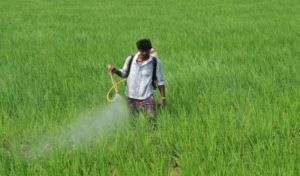Agricultural system of India witnessed a transformational change through various progressive scientific innovation. At the start, it endorses with an institute (IARI, 1905) and a council (ICAR, 1929) to boost
the agricultural its allied researches. The concurrent sectors of agriculture, horticulture, animal its breeds &
nutritional status of milk-meat, aquaculture, farm machinery and implementation in the post-harvest technology too contributed to the growth
of the Indian agriculture and boost the economy. The variable climate issue is being tackled up by climate resilient smart village concept, conservation of natural resources. Now, the country is in the course to talk about the sustainability and the economic feasibility through addressing the integrated organic farming and nutrient management models. Thus, scientific technological innovations have strength almost all the spheres of the Indian agriculture. From the last seven decades, agriculture of India feels a sharp rise fall in the contribution of GDP this might be due to the introduction of high yielding varieties opts green and other agricultural revolutions, declining of land holding capacity, non-commercialization of agriculture due to lack of suitable government policy with respect to global marketing as well as input-based production quality, declining soil fertility status due to indiscriminate use of fertilizers.

Fertilizer is the vital input material for the sustainable development of crop production and plays
an important role in food security. The worldwide experiences in agricultural development have
proved that rational fertilization is the most efficient and important measure for increasing crop
production. Indian fertilizer statistics for the production of the urea revealed that during 1 st plan
(1951 – 52) 28.9 mT of straight (nitrogenous) fertilizer only were produced which increased to
10,873.2 mT (9335 mT – straight and 1538.2 mT – complex) in 9 th plan (2000 – 01) and finally
13,744 mT (11,496.5 mT – straight and 2248 mT – complex) 12 th plan (2020 – 21) however, its
relative consumption during these plans is 55 mT, 11,592 mT and 20,404 mT respectively (FAI,
2021). It shows that the country always have a deficit of fertilizers from 1 st plan till now.
Additionally, the fertilizer is applied in a non-judicious and imbalanced manner. The difference
between the production and consumption creates a deficit of about 20% which is being imported.
Cost per 50 kg imported urea bag revealed @ ₹ 3500 and is being sold @ ₹ 300 which produces
the gap of ₹ 3200 and endured by the Indian government. Similarly, for every bag of DAP (Di-
ammonium Phosphate), government bears ₹ 2,500 against ₹ 500. This huge gap which is called
subsidy costed Indian government ₹ 1,60,000 crore every year and the pressure of fertilizers
subsidy increases at an alarming rate and the figure this year cross more than ₹ 2 lakh crore
which is being paid to the fertilizer manufacturing companies. Russia was the largest producer of
fertilizers in the world but the declining production in the present scenario creates the pressure on
the purchasing at higher price and selling at lower price by the Indian government. A sharp
deficit in the urea import has been observed due to Russia – Ukraine war which is being fulfilled
by Qatar, Egypt, China and Oman.

At the present there are 32 large sized urea plant which produces urea and led indiscriminate use of the commercial urea for synthetic milk production cause of cancer and detergent making due to its white foamy
appearance. To overcome government introduced neem coated urea whose bitterness embargo this application.
Inspite of all the expectations and fabricated efforts the government is unable to provide the required amount of the fertilizer for the soil application.
Thus, to reduce the crop pressure for obtaining yield by
fertilizers attribute the combination of basal soil as well as foliar application both suits to give
the promising results. Soil application is done to increase soils biological fertility and
concentration of mineral elements, providing big quantities of lacking nutrients while rest of the
metabolic process in the plants can be well equipped with the foliar application by spraying the
fertilizer in liquid formulation. These liquid formulations should be of very small seized i.e.,
nano or micro scale based which is due to the fact that when nano-urea is sprayed on leaves,
Nano Urea easily enters through stomata and other openings and is assimilated by the plant cells.
It is easily distributed through the phloem from source to sink inside the plant as per its need.
Unutilized nitrogen is stored in the plant vacuole and is slowly released for proper growth and
development of the plant.
Recently, Kalol Gandhi Nagar liquid nano urea plant (IFFCO) has been inaugurated on 28 th May
2022 by Hon’ble prime minister Shri Narendra Modi, which is India’s first liquid nano urea plant
which produces the liquid nano-urea of 500ml @ ₹ 240 whose active nitrogen for the plant use is
equivalent to 50 kg bag. The recommendation of this nano – urea application varies soil to soil,
crop to crop, variety to variety however in general, 2 – 3 ml bottle is dissolved in 1 lit of water
and sprinkled it on leaves and thus, 500 ml of this application is sufficient for one acer
application through knapsack sprayer, boom or power sprayer, drone etc. The application of this
nano-fertilizer is tested for several crops and results that it can be applied to cereals, pulses,
vegetables, fruits, flowers, medicinal etc.
This single unit can produce 1.5 lakh bottles per day (1.5 lakh bags of each 50 kg). IFFCO has
set up additional manufacturing facilities for production of nano-urea at Aonla, Phulphur, Kalol
(expansion), Bengaluru and Paradeep, Kandla, Deoghar and Guwahati. Other fertilizers at nano
scale (nano – micronutrient) are yet to be manufactured in which some are under trial. All these
units shall have design production capacity of 2 lakh bottles per day with a total investment of ₹
3,000 crore of which ₹ 720 crore is already committed and will generate employment for
thousands of people. This will reduce the foreign dependency with regard to urea as well as
monetary by reducing subsidy burden on government. Additionally, it saves from the
aforementioned black marketing and its application environmentally safe by reducing its losses.
The application of nano-urea is recommended initially at active tillering/branching stage. Then, it
is sprayed at 20-25 days after 1st spray or before flowering in the crop without cutting the basal
nitrogen supplied with DAP or complex but top-dressed of urea is cut off which is being applied
in 2-3 splits. Number of sprays of nano-urea can be increased or decreased depending upon crop,
its duration and overall nitrogen requirement. Chemically, nano-urea is found to be compatible
with the number of agro-chemical which can be sprayed by making the solution viz – Amino
acid, Humic acid, Sagarika liquid, Azoxystrobin 11% + Tebuconazole 18.3% SC, Hexaconazole
5% SC, Chlorpyrifos 50% + Cypermethrin 5%, Propiconazol 25% Ec, Quizalofop ethyl 5% EC,
Fipronil 5% SC, Paraquat dichloride 24% SL, Bifenthrin 10 EC, Tebuconazole 75% WP,
Thiomethoxam 30% FS, Thiamethoxam 12.6 + Lambda cyhalothrin 9.5% ZC, Pendimethalin
30% EC, Profenophos 40% + Cypermethrin 4% E, Chlorpyriphos 50% E.
In the end, the scope and relevance of nano-urea is as follows:
• It is found very effective and efficient for plant nutrition which increase the production
with improved nutritional quality.
• It will increase the balanced nutrition program by reducing the excess use of Urea
application in the soil and will make the crop stronger, healthier and protect them from
lodging (bending over of the stems near ground level which makes them very difficult to
harvest and can drastically reduce yield.
• Improves Environment by having huge positive impact on the quality of ground water, a
very significant reduction in global warming with an impact on climate change and
sustainable development.
• Increase farmers income as it is easy on the pocket of farmers and will be effective in
increasing farmers income. It will also significantly bring down the cost of transportation
and warehousing.
“With the liquid urea plant, the power of a full sack (50 kg) of urea has come into half
liter’s bottle, leading to huge saving in transportation and storage.”


